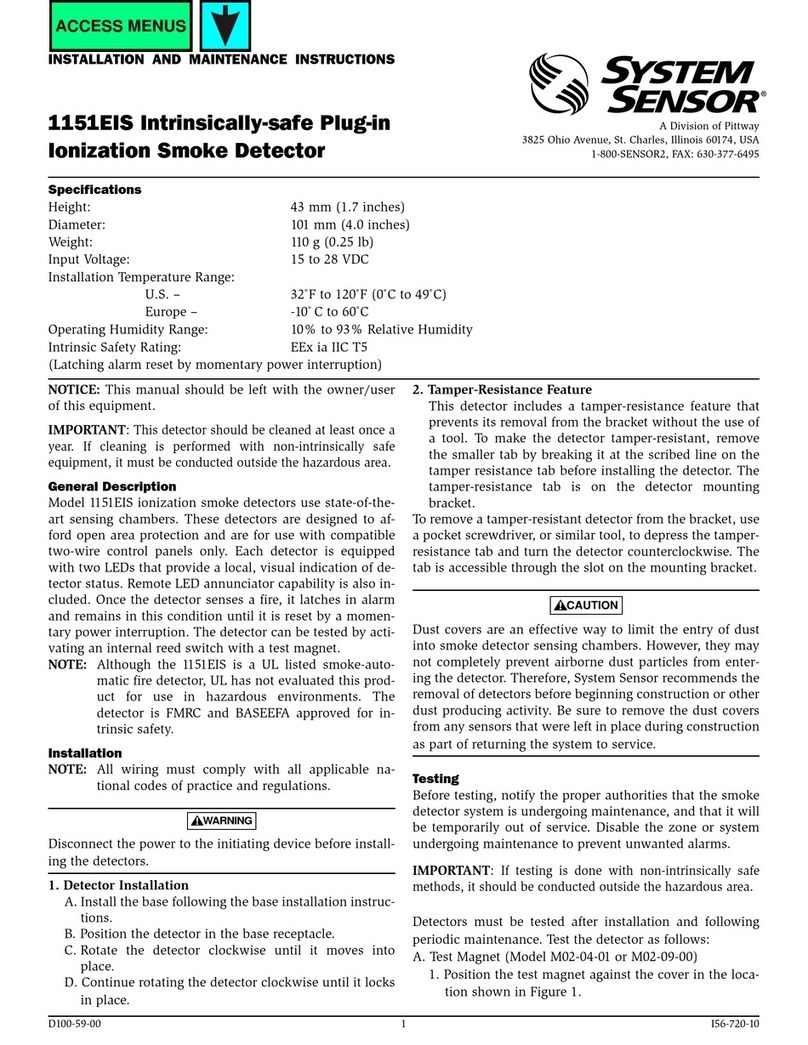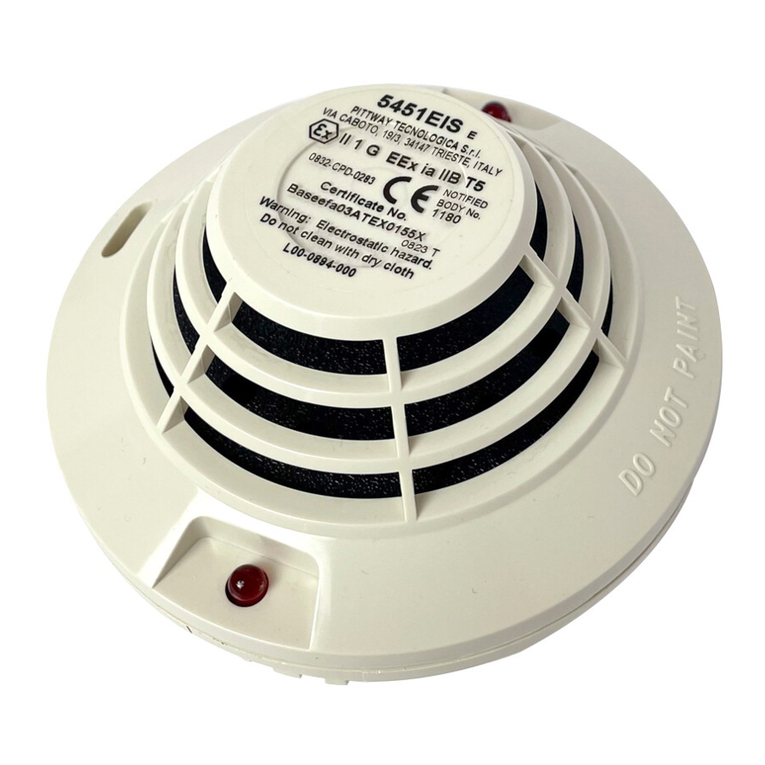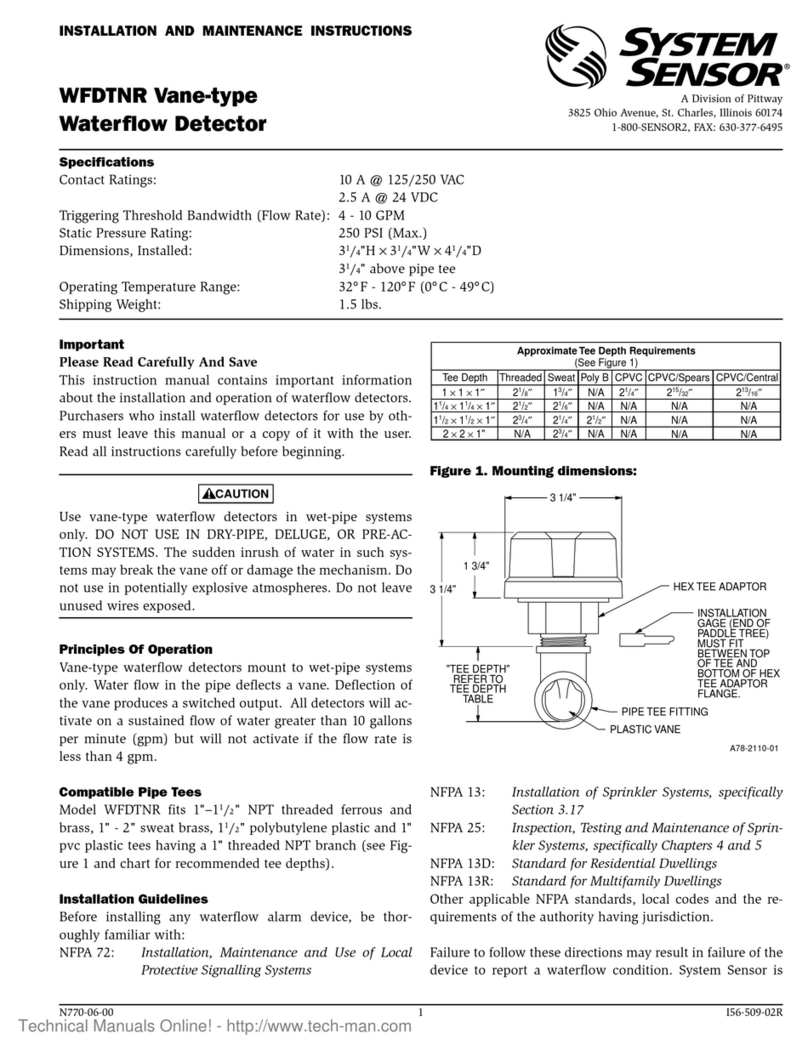
N770-05-00 4 I56-480-05R
© System Sensor 2000
Operational Testing
Always notify a central station monitoring waterflow
alarms before repairing, maintaining or testing waterflow
alarm devices.
1. Replace the cover and tighten the security screws with
the tamper proof wrench. Store the wrench in a secure
place.
2. Open the inspector’s test valve and time how long it
takes for the detector to indicate a flow condition. The
detector should remain activated until the inspector’s
test valve is closed. Air pockets in the sprinkler system
may increase the apparent time delay.
Maintenance
To prevent accidental water damage, control valves should
be shut tightly and the system completely drained before
waterflow detectors are removed or replaced.
Inspect detectors monthly for leaks. Test detectors at least
monthly as described under Operational Testing above to
insure proper operation. This device is not designed for use
on “dry pipe” systems. Test more often if required by the
authority having jurisdiction.
Under normal conditions System Sensor waterflow
detectors should provide years of trouble-free service. If,
however, the delay mechanism becomes faulty,
replacement kits are available. To replace the delay
mechanism, request Part No. A3008-00; for switch
enclosure, request Part No. A77-01-02. Complete
instructions are enclosed with each. Either mechanism can
be easily replaced without removing the detector from the
pipe or draining the pipe. If damage occurs to paddle, order
replacement kit PRK9. Refer to procedure below for
removal of detector on pipe. Do not repair or replace any
other waterflow detector components in the field. If any
other part of the detector does not perform properly,
replace the entire detector. Failure to follow this
instruction may result in failure of the detector to report
a waterflow condition.
Proceed as follows to remove a detector.
1. Drain the pipe.
2. Turn off electrical power to the detector, and then dis-
connect wiring.
3. Unscrew WFDT or WFDTH from tee fitting.
4. Lift detector clear of pipe.
CAUTION
If a vane breaks off in a pipe, find and remove it. Failure to
do so may restrict the proper flow of water to part of the
sprinkler system.
Three-Year Limited Warranty
System Sensor warrants its enclosed waterflow detector to be free from de-
fects in materials and workmanship under normal use and service for a
period of three years from date of manufacture. System Sensor makes no
other express warranty for this waterflow detector. No agent, representa-
tive, dealer, or employee of the Company has the authority to increase or
alter the obligations or limitations of this Warranty. The Company’s obli-
gation of this Warranty shall be limited to the repair or replacement of any
part of the waterflow detector which is found to be defective in materials
or workmanship under normal use and service during the three year pe-
riod commencing with the date of manufacture. After phoning System
Sensor’s toll free number 800-SENSOR2 (736-7672) for a Return Authori-
zation number, send defective units postage prepaid to: System Sensor,
Repair Department, RA #__________, 3825 Ohio Avenue, St. Charles, IL
60174. Please include a note describing the malfunction and suspected
cause of failure. The Company shall not be obligated to repair or replace
units which are found to be defective because of damage, unreasonable
use, modifications, or alterations occurring after the date of manufacture.
In no case shall the Company be liable for any consequential or incidental
damages for breach of this or any other Warranty, expressed or implied
whatsoever, even if the loss or damage is caused by the Company’s negli-
gence or fault. Some states do not allow the exclusion or limitation of inci-
dental or consequential damages, so the above limitation or exclusion may
not apply to you. This Warranty gives you specific legal rights, and you
may also have other rights which vary from state to state.
WARNING
The Limitations of Waterflow Alarm Devices
1. Waterflow detectors may not work or operate properly if
sprinkler piping being monitored is plugged with pipe
scale, mud, stones or other foreign material. Sprinkler
systems should be checked regularly for such blocking
material, following the instructions in NFPA Standard 25.
2. Alarms generated by the activation of waterflow detec-
tors may not be received by a central station if telephone
or other communication lines to the detector are out of
service, disabled, or open.
3. Vane-type waterflow detectors have a normal service life
of 10-15 years. Hard water systems, however, may re-
duce waterflow detector service life to 4 or 5 years.
4. If valves controlling the water supply to a sprinkler sys-
tem are closed, vane-type waterflow detectors will not
work. All valves controlling a sprinkler water supply
should be sealed or locked in the normally open posi-
tion. The normally open position should be monitored
by a sprinkler supervisory switch.
Please refer to insert for the Limitations of Fire Alarm Systems
Technical Manuals Online! - http://www.tech-man.com

























